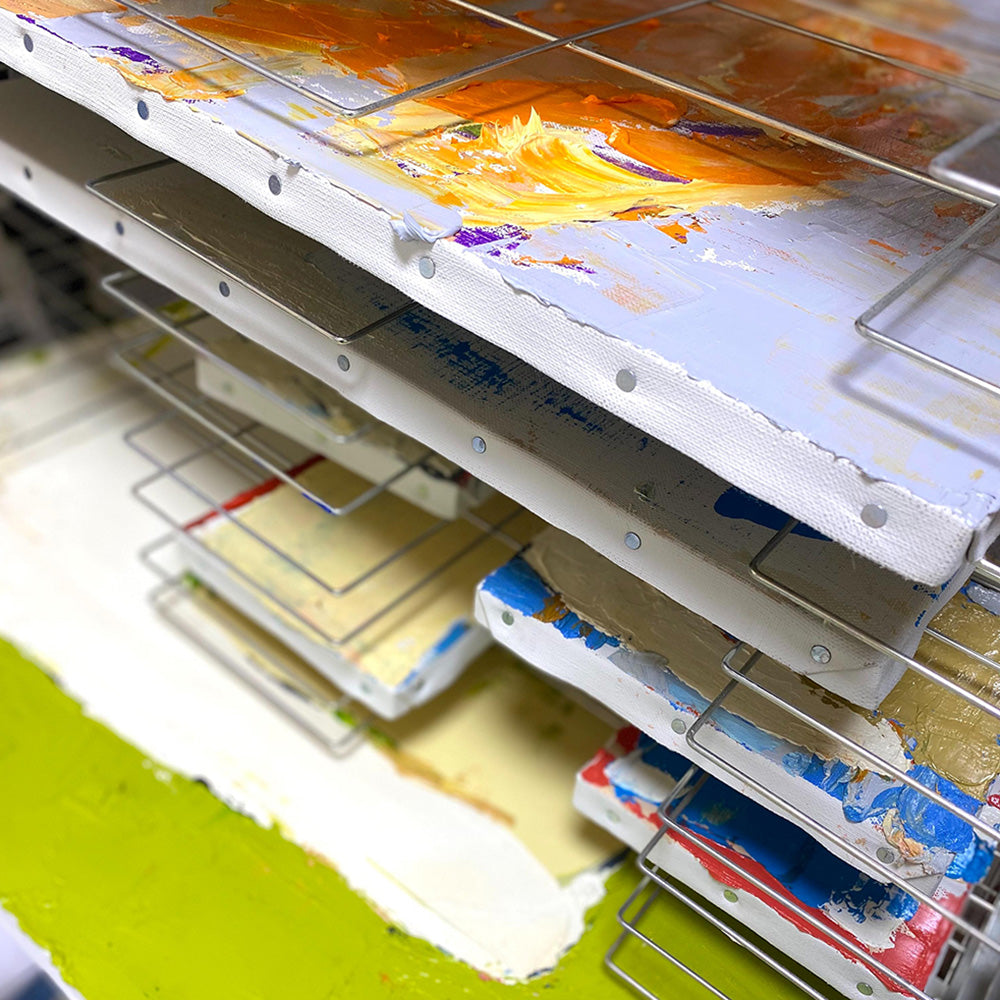The image is from Yumiko Takimoto 's atelier.
There are a certain number of people who say, "I don't really understand abstract art." I can understand that feeling very well. Actually, I feel the same way. But my personal opinion is that it's normal not to understand, and there's no need to force yourself to understand.
Now that we're at it, let's consider the meaning of the word "abstract."
This is a very rough explanation, but here's my interpretation:
"Concrete" = clear and distinct
"Abstract" = vague
It's not about the resolution being high or low, but it's something like this...
The same applies to paintings. Paintings that depict visible things, such as people or landscapes, as they are, are called "representational paintings." In contrast, "abstract paintings" are those in which the painter freely expresses what they feel or think. Basically, it might be easier to understand if you think of them as works that depict things that are not visible.
The greatest appeal of abstract art is undoubtedly its freedom. Not only are there no concrete shapes or objects depicted, but often the artist doesn't have a clear intention behind the work. This allows the viewer to interpret the meaning of the piece based on their own feelings and experiences. Therefore, even the same painting can be perceived differently by different people, and the fact that new discoveries can be made each time one views it is another delightful characteristic.
Now, while some abstract paintings do use landscapes or figures as motifs, they aren't depicted concretely; instead, the shapes and colors are abstracted. For example, in "abstract landscape paintings" that depict mountains or seascapes, only the impression of the landscape is expressed using color and lines. While an abundance of blue and green might evoke the image of "sea," different viewers may conjure up different images. It's perfectly normal for the same person to see the sea one day and feel a sense of inner peace the next (laughs).
In addition, "abstract figure paintings" express human faces and bodies with geometric shapes and lines, allowing you to vaguely sense the figure and movement of a person. A famous example would be Picasso's Cubist works , in which figures are decomposed and depicted from various angles, offering a unique and enjoyable style of expression. If you have the opportunity, please be sure to see them.
In this way, abstract art is a form of art that gives viewers joy and the pleasure of thinking. There's no need to worry. Ignoring the feeling of understanding or not understanding, why not find your own way to enjoy it while feeling the possibility of free expression and diverse interpretations? You'll enjoy looking at it every day.
You can view our selection of abstract paintings, which features works by up-and-coming and established Japanese artists, here .
■ For reference, I've compiled various techniques and styles of abstract painting.
1. Geometric Abstraction
This is a style of painting that uses simple shapes like squares and circles. Order and overall balance are very important. For example, Piet Mondrian 's paintings are made with a combination of straight lines and primary colors; they look simple at first glance, but are actually very carefully designed upon closer inspection.
● Points to look for: The key might be to enjoy the combination of shapes and colors from a slightly detached perspective, focusing on how they balance each other.
2. Lyrical Abstraction
These works seem to directly express the artist's emotions and inspiration. Many of them are drawn freely, without regard for rules. Works by Joan Miró and Wassily Kandinsky are famous examples, all of which are colorful and feature many unique shapes.
● Points to note: Instead of trying to find some kind of pattern, it's best to just look at it as you feel in that moment.
3. Color Field Painting
This is a style that focuses on the enjoyment of color itself. There are almost no shapes, just expansive colors that you look at and consider how they make you feel. Mark Rothko 's work is a typical example, and his paintings give the impression of large layers of color spreading out softly.
● Points to look out for: Take your time to enjoy the range of colors and the subtle changes in color tones.
4. Abstract Expressionism
This is an explosion of emotion! The artist's inner world is directly expressed in the painting. Jackson Pollock, famous for his action painting, is known for his "dripping technique," in which he splashes paint onto the canvas to create dynamic works.
●Points to look out for: Try to sense the dynamic movement in the artwork and imagine the artist's feelings at that moment; it might be fun.
5. Minimal Art
It's extremely simple art. All unnecessary elements are removed, and it's composed of only the bare minimum of shapes and colors. Donald Judd 's works are famous examples, and they have an inorganic, cool impression.
● Points to note: The beauty of minimalist art lies in appreciating the balance and atmosphere within its simplicity.
6. Op Art
This is art that uses optical illusions. Some works, through the use of patterns and colors, even appear to be moving. Looking at Victor Vasarely 's works creates a strange sensation as your eyes play tricks on you.
● Points to note: It's interesting to observe how your eyes are being tricked, by gradually moving closer and further away.






